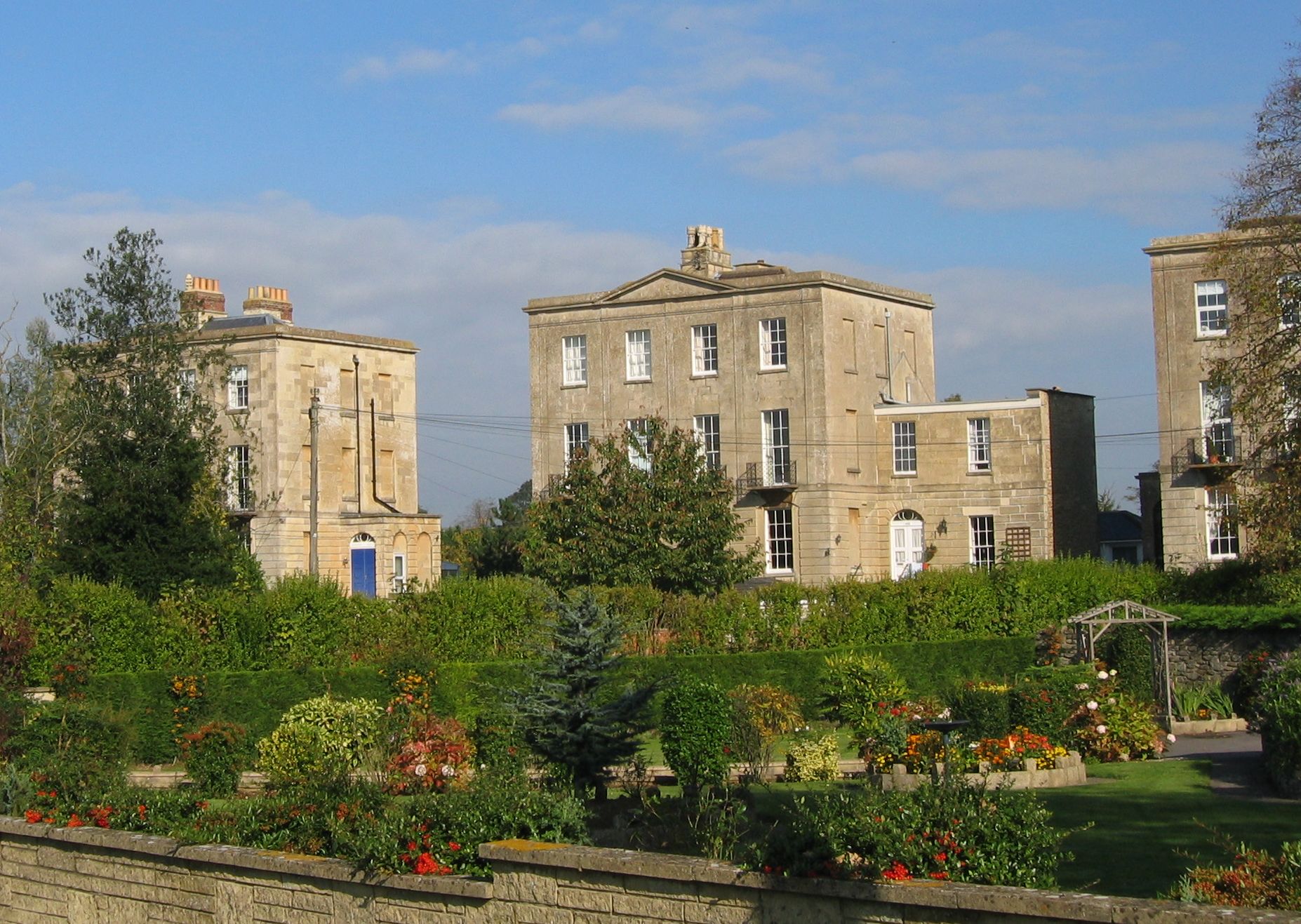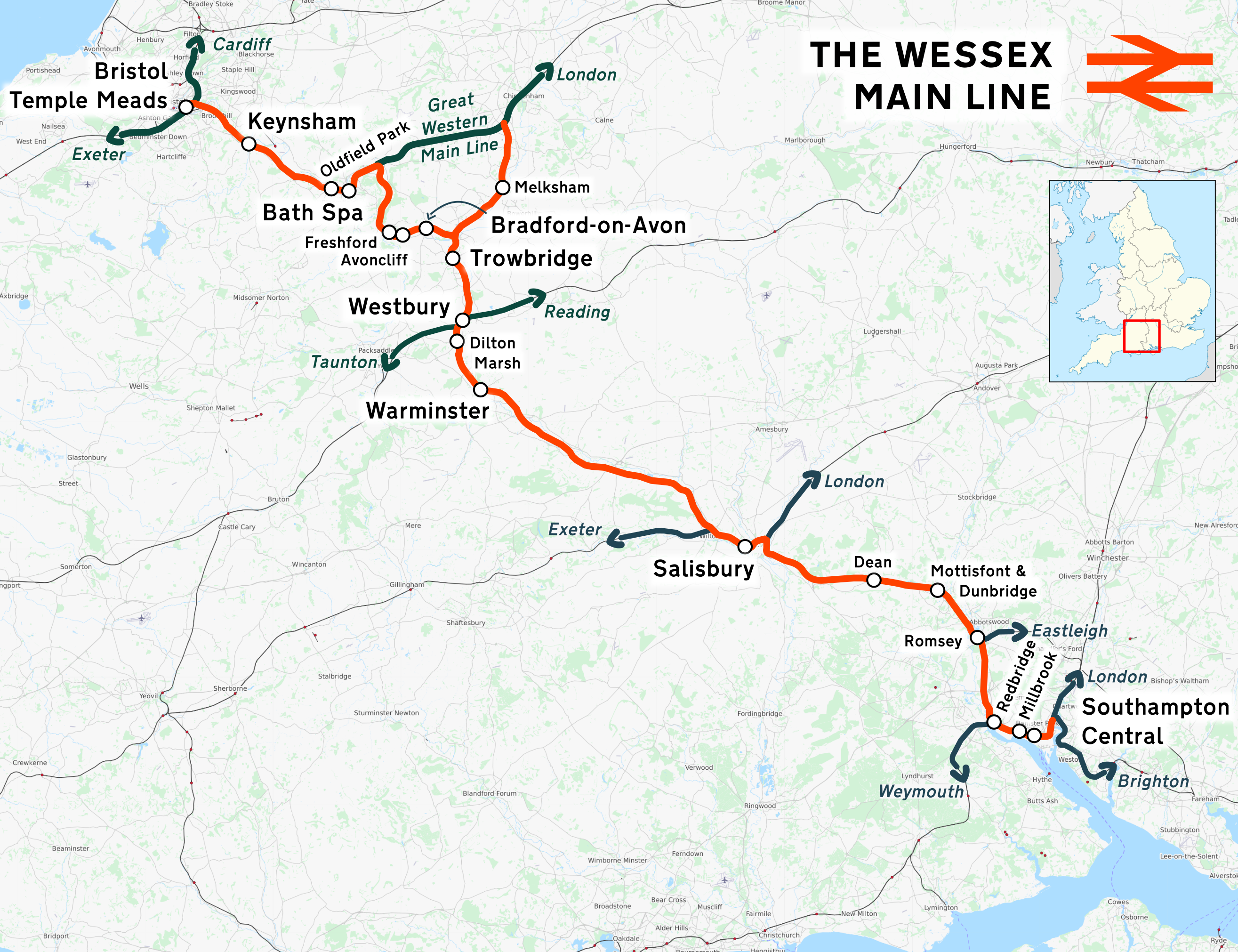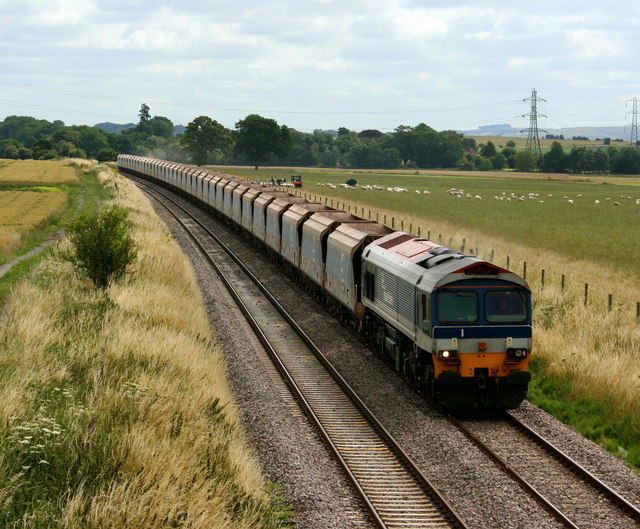|
Melksham Railway Station
Melksham railway station serves the town of Melksham in Wiltshire, England. It is measured from , on the TransWilts Line between and that was originally part of the Wilts, Somerset and Weymouth Railway, absorbed in 1850 by the Great Western Railway. History The station opened with the original section of the line between Thingley Junction and Westbury, on 5 September 1848. British Railways closed the station from 18 April 1966 and soon afterwards the line through the station was singled, the station buildings demolished, and the up platform removed. The station reopened to passengers from 13 May 1985, although the short platform meant that trains longer than one carriage could not open all doors. In July 2018, the platform was improved and lengthened to cater for trains of up to three carriages. The station had a siding which gave access to the former Wiltshire United Dairies/United Dairies creamery, last owned by Co-operative Wholesale Society Dairies, allowing access ... [...More Info...] [...Related Items...] OR: [Wikipedia] [Google] [Baidu] |
Melksham
Melksham () is a town on the River Avon in Wiltshire, England, about northeast of Trowbridge and south of Chippenham. At the 2011 census, the Melksham built-up area had a population of 19,357, making it Wiltshire's fifth-largest settlement after Swindon, Salisbury, Chippenham and Trowbridge. History Early history Excavations in 2021 in the grounds of Melksham House found fragments of locally made pottery from the early Iron Age (7th to 4th centuries BC). There is evidence of settlement continuing into the later Iron Age and Roman periods, including Roman clay roof tiles. Melksham developed at a ford across the River Avon. The name is presumed to derive from "''meolc''", the Old English for milk, and ''"ham"'', a village. On John Speed's map of Wiltshire (1611), the name is spelt both ''Melkesam'' (for the hundred) and ''Milsham'' (for the town itself). Melksham is also the name of the Royal forest that occupied the surrounding of the area in the Middle Ages. Landowne ... [...More Info...] [...Related Items...] OR: [Wikipedia] [Google] [Baidu] |
Foster Yeoman
Foster Yeoman Limited, based near Frome, Somerset, England, was one of Europe's largest independent quarrying and asphalt companies. It was sold to Aggregate Industries in 2006. History The company was founded by Foster Yeoman, from Hartlepool, at Dulcote, near Wells, in 1923. He was a former ship owner and had worked in the iron and steel business. Yeoman had served in the First World War and went into quarrying to provide employment for ex-soldiers. Between the wars Foster Yeoman Limited supplied contractors and local authorities in the South of England, reaching an early peak of prosperity in the 1930s. During the Second World War, the firm supplied materials for the construction of airfields. Most stone was sent away by rail as it is today. After the war, with Foster Yeoman ailing, business declined and the company came full circle, returning to the £20,000 turnover it had enjoyed in 1923. In 1949, Foster died and his son, John Foster Yeoman, became a managing director at ... [...More Info...] [...Related Items...] OR: [Wikipedia] [Google] [Baidu] |
Railway Stations Served By Great Western Railway
Rail transport (also known as train transport) is a means of transport that transfers passengers and goods on wheeled vehicles running on rails, which are incorporated in tracks. In contrast to road transport, where the vehicles run on a prepared flat surface, rail vehicles (rolling stock) are directionally guided by the tracks on which they run. Tracks usually consist of steel rails, installed on sleepers (ties) set in ballast, on which the rolling stock, usually fitted with metal wheels, moves. Other variations are also possible, such as "slab track", in which the rails are fastened to a concrete foundation resting on a prepared subsurface. Rolling stock in a rail transport system generally encounters lower frictional resistance than rubber-tyred road vehicles, so passenger and freight cars (carriages and wagons) can be coupled into longer trains. The operation is carried out by a railway company, providing transport between train stations or freight customer faciliti ... [...More Info...] [...Related Items...] OR: [Wikipedia] [Google] [Baidu] |
Former Great Western Railway Stations
A former is an object, such as a template, gauge or cutting die, which is used to form something such as a boat's hull. Typically, a former gives shape to a structure that may have complex curvature. A former may become an integral part of the finished structure, as in an aircraft fuselage, or it may be removable, being using in the construction process and then discarded or re-used. Aircraft formers Formers are used in the construction of aircraft fuselage, of which a typical fuselage has a series from the nose to the empennage, typically perpendicular to the longitudinal axis of the aircraft. The primary purpose of formers is to establish the shape of the fuselage and reduce the column length of stringers to prevent instability. Formers are typically attached to longerons, which support the skin of the aircraft. The "former-and-longeron" technique (also called stations and stringers) was adopted from boat construction, and was typical of light aircraft built until the a ... [...More Info...] [...Related Items...] OR: [Wikipedia] [Google] [Baidu] |
Railway Stations In Great Britain Opened In 1985
Rail transport (also known as train transport) is a means of transport that transfers passengers and goods on wheeled vehicles running on rails, which are incorporated in tracks. In contrast to road transport, where the vehicles run on a prepared flat surface, rail vehicles (rolling stock) are directionally guided by the tracks on which they run. Tracks usually consist of steel rails, installed on sleepers (ties) set in ballast, on which the rolling stock, usually fitted with metal wheels, moves. Other variations are also possible, such as "slab track", in which the rails are fastened to a concrete foundation resting on a prepared subsurface. Rolling stock in a rail transport system generally encounters lower frictional resistance than rubber-tyred road vehicles, so passenger and freight cars (carriages and wagons) can be coupled into longer trains. The operation is carried out by a railway company, providing transport between train stations or freight customer facil ... [...More Info...] [...Related Items...] OR: [Wikipedia] [Google] [Baidu] |
Railway Stations In Great Britain Closed In 1966
Rail transport (also known as train transport) is a means of transport that transfers passengers and goods on wheeled vehicles running on rails, which are incorporated in tracks. In contrast to road transport, where the vehicles run on a prepared flat surface, rail vehicles (rolling stock) are directionally guided by the tracks on which they run. Tracks usually consist of steel rails, installed on sleepers (ties) set in ballast, on which the rolling stock, usually fitted with metal wheels, moves. Other variations are also possible, such as "slab track", in which the rails are fastened to a concrete foundation resting on a prepared subsurface. Rolling stock in a rail transport system generally encounters lower frictional resistance than rubber-tyred road vehicles, so passenger and freight cars (carriages and wagons) can be coupled into longer trains. The operation is carried out by a railway company, providing transport between train stations or freight customer facilit ... [...More Info...] [...Related Items...] OR: [Wikipedia] [Google] [Baidu] |
Railway Stations In Great Britain Opened In 1848
Rail transport (also known as train transport) is a means of transport that transfers passengers and goods on wheeled vehicles running on rails, which are incorporated in tracks. In contrast to road transport, where the vehicles run on a prepared flat surface, rail vehicles (rolling stock) are directionally guided by the tracks on which they run. Tracks usually consist of steel rails, installed on sleepers (ties) set in ballast, on which the rolling stock, usually fitted with metal wheels, moves. Other variations are also possible, such as "slab track", in which the rails are fastened to a concrete foundation resting on a prepared subsurface. Rolling stock in a rail transport system generally encounters lower frictional resistance than rubber-tyred road vehicles, so passenger and freight cars (carriages and wagons) can be coupled into longer trains. The operation is carried out by a railway company, providing transport between train stations or freight customer facilit ... [...More Info...] [...Related Items...] OR: [Wikipedia] [Google] [Baidu] |
Railway Stations In Wiltshire
Rail transport (also known as train transport) is a means of transport that transfers passengers and goods on wheeled vehicles running on rails, which are incorporated in tracks. In contrast to road transport, where the vehicles run on a prepared flat surface, rail vehicles (rolling stock) are directionally guided by the tracks on which they run. Tracks usually consist of steel rails, installed on sleepers (ties) set in ballast, on which the rolling stock, usually fitted with metal wheels, moves. Other variations are also possible, such as "slab track", in which the rails are fastened to a concrete foundation resting on a prepared subsurface. Rolling stock in a rail transport system generally encounters lower frictional resistance than rubber-tyred road vehicles, so passenger and freight cars (carriages and wagons) can be coupled into longer trains. The operation is carried out by a railway company, providing transport between train stations or freight customer facil ... [...More Info...] [...Related Items...] OR: [Wikipedia] [Google] [Baidu] |
Wessex Main Line
The Wessex Main Line is the railway line from Bristol Temple Meads to Southampton Central. Diverging from this route is the Heart of Wessex Line from Westbury to Weymouth. The Wessex Main Line intersects the Reading to Taunton Line at and the West of England Main Line at . Places served The places served are listed below. *Bristol Temple Meads * Keynsham * Oldfield Park * Bath Spa ** Great Western Main Line diverges to Chippenham, Swindon and London Paddington * Freshford *Avoncliff *Bradford-on-Avon *Trowbridge * Westbury **Heart of Wessex Line diverges to Weymouth *Dilton Marsh *Warminster *Salisbury *Dean * Mottisfont & Dunbridge * Romsey ** Eastleigh to Romsey Line diverges to Chandler's Ford and Eastleigh *Southampton Passenger services are currently operated by Great Western Railway Portsmouth - Cardiff services, supplemented by South Western Railway between Salisbury and Southampton, and by Great Western high-speed express services between Bristol and Bath. Some s ... [...More Info...] [...Related Items...] OR: [Wikipedia] [Google] [Baidu] |
Whatley, Mendip
Whatley is a small rural village and civil parish about west of Frome in the English county of Somerset. The parish lies south of Mells and north of Nunney, and includes the hamlets of Lower Whatley and Chantry. History According to Robinson, it was called ''Watelei'' in the Domesday Book of 1086, when the tenants of the Abbot of Glastonbury Abbey were Walter Hussey and John the Usher. He suggests the village name means 'The wet meadow' from the Old English ''woet'' and ''leah''. The parish was part of the hundred of Frome. The village gives its name to Whatley Quarry, which lies to the north-west of the village at and is said to be one of the largest in Europe. It is owned by Hanson plc and has been the object of protests against its impact on the environment. The gatehouse at Manor farm was built around 1500 and is a Grade I listed building. The hamlet of Lower Whatley is to the south of the village. The hamlet of Chantry lies 1 mile to the west. It is one of the Thankf ... [...More Info...] [...Related Items...] OR: [Wikipedia] [Google] [Baidu] |
Mendip Rail
Mendip Rail Ltd is an independent freight operating railway company in Great Britain. It is a joint venture composed of the rail-operation divisions of Aggregate Industries (formerly Foster Yeoman) and Hanson Aggregates (previously ARC). The company operates aggregate trains from the quarries of the Mendip Hills in South-West England, to London and South-East England. The Foster Yeoman quarries are at Torr Works and Dulcote Quarry, while Hanson has plants at Batts Combe Quarry and Whatley Quarry. The company operates four Class 59/0 diesel locomotives owned by Aggregate Industries and four Class 59/1 locomotives owned by Hanson. In addition, two SW1001 Switchers are owned and operated at Whatley and Merehead quarries. It owns Merehead Traction Maintenance Depot (Merehead TMD) where the eight locomotives are allocated. They can also be seen at Hither Green TMD or Eastleigh Works where they receive heavy maintenance. Foster Yeoman Foster Yeoman purchased its own fleet of 14 ... [...More Info...] [...Related Items...] OR: [Wikipedia] [Google] [Baidu] |
Freightliner Group
Freightliner Group is a rail freight and logistics company headquartered in the United Kingdom. It is presently a wholly owned subsidiary of the American holding company Genesee & Wyoming. It was originally created after the Transport Act 1968 as ''Freightliner Ltd'', a British government-owned company . From its onset, Freightliner was focused on the haulage of international traffic, thus came to centre its activities around Britain's sea ports, often building new multimodal freight depots adjacent to such locations to better capture this business. During the late 1970s, it was reorganised under British Rail, and became a part of its Railfreight Distribution subsidiary during the late 1980s. Work to expand the loading gauge on routes such as the East Coast Main Line were undertaken, allowing trains hauling larger containers to be routes, were conducted around this time. Numerous domestic depots previously operated by Freightliner were closed during the 1990s in preparation for t ... [...More Info...] [...Related Items...] OR: [Wikipedia] [Google] [Baidu] |









